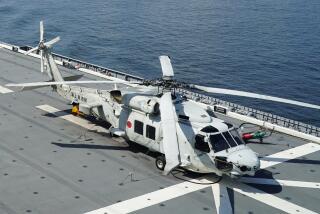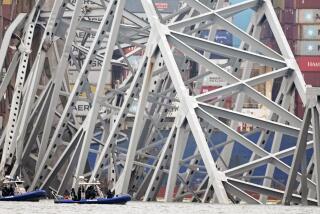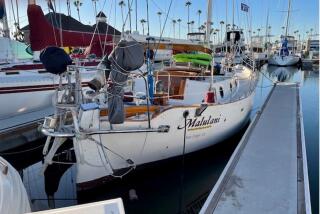Sounds detected might be from Malaysia Airlines Flight 370

Two distinct long-lasting sounds underwater give authorities searching for the missing Malaysia Airlines jet their best lead so far. But they urge caution.
BEIJING -- An Australian ship towing a U.S. Navy “pinger” locator has twice picked up sustained signals that may be from missing Malaysia Airlines Flight 370’s “black boxes,” and searchers are likely to deploy an underwater exploratory vehicle soon to look for wreckage, authorities said Monday.
The first acoustic event detected by the Ocean Shield lasted two hours and 20 minutes, and the second lasted 13 minutes, said Australian Air Chief Marshal Angus Houston, who is coordinating search efforts from Perth, Australia.
“We are encouraged we are very close to where we need to be,” said Houston, describing the finding as the best lead so far in the quest to find the missing Boeing 777. However, he urged the media and the public to treat the news “cautiously and responsibly.”
FOR THE RECORD:
Flight 370: An article in the April 7 Section A about the detection of “pings” that could be from missing Malaysia Airlines Flight 370 said a Chinese patrol ship had picked up 37.5 MHz pulses, the same frequency emitted by a flight data recorder. The pulses were 37.5 KHz. —
Houston said that for perhaps the next 24 hours, the Ocean Shield would continue passing slowly over the area where the signals were detected, trying to get a better fix on the actual location.
Commodore Peter Leavy of the Australian navy said if the crew detects the signal a third time, “that will be the trigger to launch the underwater vehicle with the sonar” to explore for wreckage.
However, with the search now in its 31st day and batteries on the black box pingers nearing the end of their expected life, searchers may decide to deploy the underwater search vessel regardless.
The beacon or pinger is a battery-powered device attached to a recorder that radiates a pulsed acoustic signal into the surrounding water upon activation by its water-sensitive switch.
Cmdr. William Marks of U.S. 7th Fleet, who is aboard the Ocean Shield, said the towed pinger locator was only about 985 feet deep when it began detecting the pings at one-second intervals. “We were not overly optimistic,” he told CNN by satellite phone from the ship.
But after lowering the towed pinger locator to nearly 4,600 feet, the crew was able to get hold of the signal for more than two hours.
Marks noted that if the signal was coming from a black box, the signal should get stronger and then fade as the locator passed over the site. “That’s what happened,” Marks said, describing searchers as “cautiously optimistic.”
Crews then did a course change and passed back over the area, lowering the towed pinger locator to about 9,850 feet, which Marks called the “optimal depth.” Crews were able to pick up a signal for about 15 minutes, he said.
According to Houston, the area where the signals were detected has a depth of about 14,800 feet -- the maximum depth the underwater vehicle can operate in. He cautioned that “in very deep oceanic water, nothing happens fast” and that it could take “some days” to establish whether this is connected with Flight 370.
The Ocean Shield was about 300 nautical miles north of the Chinese ship Haixun 01, which on Friday and Saturday also reported picking up acoustic signals at 37.5 kHz, the preset frequency for pingers attached to airplane flight data recorders and cockpit voice recorders.
The ships were both along an arc that investigators analyzing satellite data think represents the most likely area where the jet entered the water.
Recovering the flight data recorder and cockpit voice recorder is crucial to understanding how and why the airplane vanished en route from Kuala Lumpur to Beijing on March 8 with 239 people aboard. Malaysian investigators have said they believe the plane’s disappearance was the result of a deliberate act by someone aboard the aircraft, but beyond that the circumstances remain shrouded in mystery.
One pinger is attached to the flight data recorder, which is embedded in the rear section of the jetliner’s fuselage. Another pinger is attached to the cockpit voice recorder. The voice recorder has two hours of memory, while the data recorder has 25 hours.
[For The Record, 4:02 a.m. PDT April 7: An earlier version of this post said the Ocean Shield picked up acoustic signals at 37.5 MHz. The signals were at 37.5 kHz.]
Times staff writer W.J. Hennigan in Los Angeles contributed to this report.
Twitter: @JulieMakLAT
More to Read
Start your day right
Sign up for Essential California for news, features and recommendations from the L.A. Times and beyond in your inbox six days a week.
You may occasionally receive promotional content from the Los Angeles Times.






